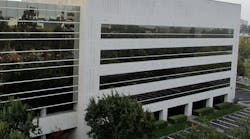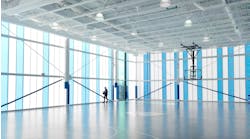What Causes the Pattern Effect?
The primary catalyst for structure striping on building exteriors is the cyanobacteria Gloeocapsa magma (GM). Moisture is required for the dark bacteria to grow and become apparent.
Trending: Top 5 Envelope Failures and Water Leaking Solutions
The stripe pattern occurs due to transfer of heat from structural components, including studs, rafters, headers, plates, etc.
Oracle Arena in Oakland, California, home of the Golden State Warriors
With the transfer of heat from internal structural members to the building surface, areas in direct contact with the heated structural framing dry quicker than other areas, such as open or insulated bays. In areas not heated by underlying framing, bacteria are able to flourish. Over time this results in a pattern that clearly shows the framework of structural components just below the building’s exterior surface.
Roofs are Affected by Structure Striping
This striping phenomenon is not only found on walls, but on roofing as well—particularly composition asphalt roofs, with rafters serving to transfer the heat. In residential roofing, growth near the perimeter is particularly evident, causing dark shading at overhangs and eaves, since there is no heat transfer from the interior of the home.
Related: 3 Vital Roles of Roofing Insulation
Wood and tile roofs do not typically exhibit bacterial striping. The reason these materials are relatively unaffected by bacterial growth is due to their thicker dimension and insulative properties. Tile roofs, when correctly installed and insulated, create a thermal barrier that doesn’t come into contact with the heat transferred by structural members.
Roofing can have structure striping too.
While darker colors downplay the pattern effect, lighter colors make striping more pronounced. And, as the bacteria are allowed to proliferate and darken with time, areas subject to GM bacterial growth become much more concentrated and visible in areas with nonexistent or irregular insulation.
On topic: Is Your Envelope Leaking Money?
While virtually all areas in the U.S. are subject to the growth of the dark, GM bacteria, the striping pattern is generally only seen in moderate climates. This is because structures built in colder climates have much higher standards for insulation, which limit the release of internal heat to the exterior. Solid building materials, such as brick and mortar, also disperse heat equally and show no effects of structure striping.
Large Commercial Surfaces Accentuate Structure Striping
Smaller residential homes with many windows, doors and comparatively detailed exteriors tend to obscure the pattern effect.
On the other hand, commercial buildings with large monotone, single-color surfaces are much more prone to the effects of structure striping. The pattern is clearly visible and results from both metal and wood framing.
The Most Effective Way to Remove Structure Striping
The safest, most effective way to remove the bacteria that causes structure striping is using a non-pressure, chemical cleaning process.
There are three distinct reasons for this:
1. Chemical or “soft wash” cleaning eliminates bacteria as the source of the staining. Because the bacteria itself is being remediated, it takes years in most cases for regrowth to occur, to the point where it may become visible again.
2. The chemical solution to remove structure striping is a safe yet powerful oxidizer. This results in the immediate and generally complete removal of any discoloration.
TCU after safe washing.
3. Perhaps most importantly, is the efficacy of soft (safe) washing. Contract cleaners have traditionally used high pressure for exterior cleaning. As mentioned earlier, structure striping typically occurs in moderate climates. The most common exterior building finishes and materials used in these climates are relatively delicate coatings, applied over gypsum and acoustic board. High pressure has proven to be an ineffective means to remove bacterial structure striping in most cases.
The use of high pressure has caused irreversible damage to many costly building exteriors. This is not just due to human error: the use of high pressure is simply the wrong approach to cleaning many modern building exteriors.
Eric Schnaible, Exterior Restoration Specialist with Pacific Exterior in Santa Cruz, CA. *Photo credits: Eric Schnaible
Two hand-picked articles to read next:


